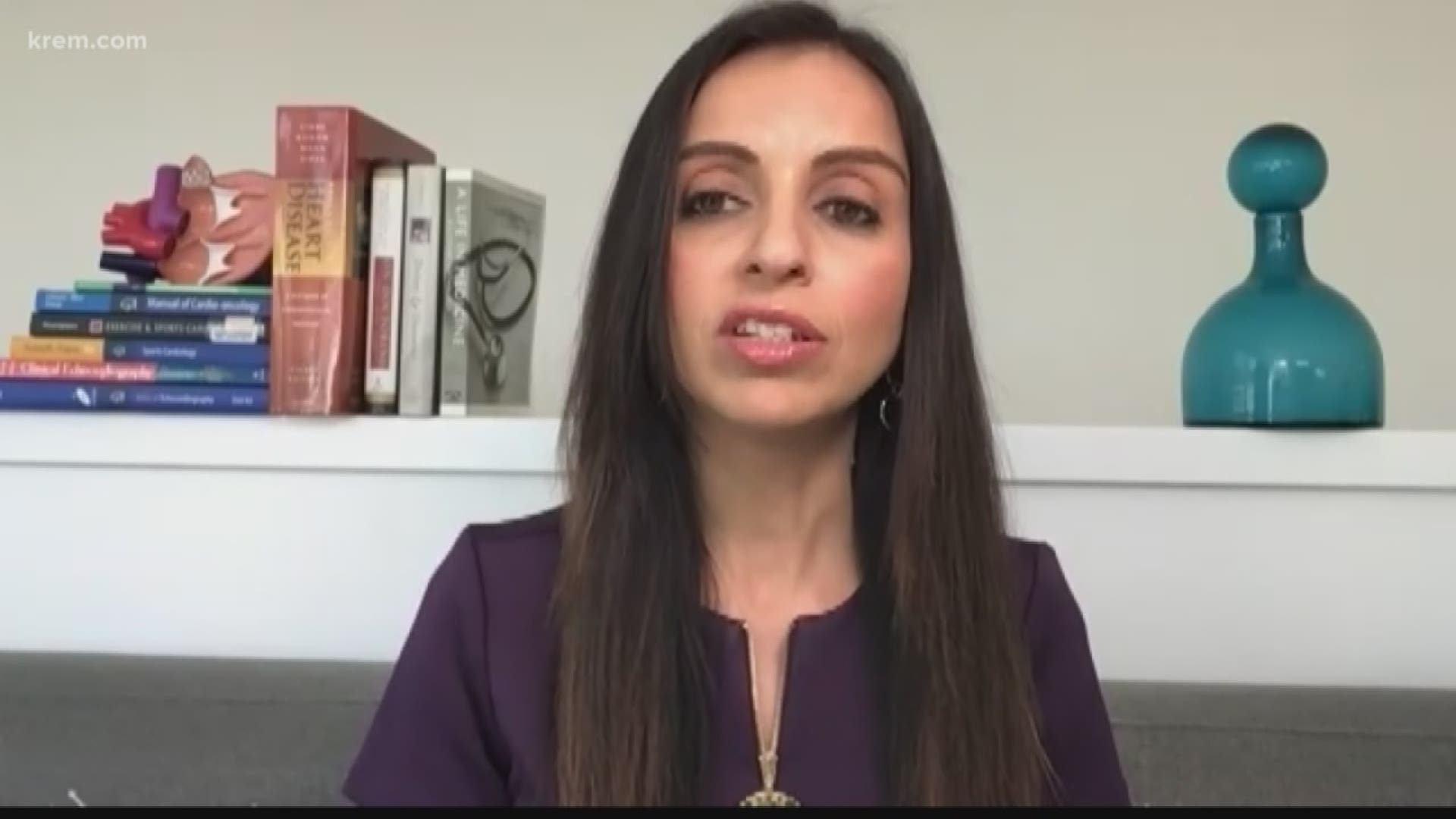SPOKANE, Wash. — Uncertainty lingers for Washingtonians and people throughout the United States amid the coronavirus pandemic.
A question at the forefront of people's minds: when could socially distancing realistically end in our states and our country as a whole?
On Thursday, Spokane County Health Officer Dr. Bob Lutz said people should probably expect to see some form of social distancing requirements through the end of May.
“I think all the data are demonstrating that social distancing is having an impact and will continue to have an impact as long as we keep to it," he said during a briefing. "If we let up the brakes too quickly, we’re going to find ourselves plunging back to where we were before.”
Washington Gov. Jay Inslee's "Stay Home, Stay Healthy" order was recently extended through May 4.
KREM took some of our questions to Dr. Payal Kohli, who works with KREM's sister station KUSA in Denver, Colorado. She is an internationally-recognized cardiologist, and leader in cardiovascular research and disease prevention.


Could social distancing end in Washington earlier than other states?
Dr. Kohli recommended that U.S. leaders look at a unified effort to releasing people from social distancing guidelines rather than doing this with individual states as "every single part of the country has a different curve."
“The danger with doing a disjointed or not nationally unified effort is that the virus doesn’t really fall into geographical boundaries," she said.
If social distancing were released in Washington state, for example, the state could see another huge wave of cases as residents travel and begin intermingling with other people.
“I think what’s most likely to be successful is a coordinated national strategy. Unfortunately, there has been a bit of this disjointed approach, with each state’s governor making individual decisions about stay-at-home orders, about wearing masks, about restrictions that they’re placing on their communities," Dr. Kohli added.
When can we lift social distancing requirements?
Dr. Kohli also outlined what she called the "three T's" that need to happen before social distancing requirements are lifted in the United States.
The first is testing, meaning we could perform widespread antibody testing to find out who has already developed immunity to the virus and then selectively release those individuals first to return to their normal lives.
Those who have developed an antibody are not a risk to themselves because they have already had the virus and are not at risk of spreading it to others, Dr. Kohli said.
The second T is contract tracing. Dr. Kohli said one of the weaknesses in how the virus got out of hand in the first place was a lack of data about who is interacting with people and who is exposing others.
The third T is treatment and vaccine. Though a vaccine for coronavirus is still about a year away, Dr. Kohli said it is critical to have one before we return to normal life. In the short-term, we need to develop at least a few treatments that are relatively effective.
"If there are more cases of COVID-19 that resurge, then we’re prepared to handle them," Dr. Kohli added.
What could happen if we release social distancing requirements too early?
Dr. Kohli reiterated that social distancing is aimed at flattening the curve rather than reducing the number of coronavirus cases.
These measures will not necessarily reduce the number of cases and instead will space out how many people get sick at any given time in hopes of preventing an overwhelmed health care system.
"If we are successful, we will have cases for a longer period of time, which means stay-at-home orders could go for longer, but we will keep more people alive by not overwhelming healthcare systems," Dr. Kohli said. “What history has taught us…is that if you release social distancing too early that you are going to get a huge wave of cases.”
Dr. Kohli referred specifically to the Spanish Flu, a pandemic in 1918 that infected nearly 50 million people, saying it is eerily similar to COVID-19 in that was it was a new virus with no immunity or vaccine.
“It was very difficult at that time to practice full social distancing," she added.
When could we return to normal life?
Until we have a vaccine for coronavirus, our lives may look very different.
“When Dr. Fauci was asked this question, he categorically said that our life as we knew it pre-coronavirus – until we have a vaccine – is probably over," Dr. Kohli said.
She added that the ability to hold concerts and large gatherings and travel without giving it a thought "is not going to happen in the near future." But there is hope that we can return to some parts of our lives as New York nears its peak, and states such as Washington and California are flattening their curves.
“With this in mind, I think by this summer we could be optimistic that some of us could go back to our lives and that maybe we could have some sort of a new normal," Dr. Kohli said.
When would we know that outbreaks in the U.S. are slowing down?
According to Dr. Kohli, some epidemiologists say that fewer than 60 new cases or deaths every day may be an indication that the pandemic is starting to slow down in the U.S.
Models used by the White House are taking into account social distancing through the end of May, she added.
“For most people, I think that’s going to be very much a reality because the models are even assuming that we’re going to be socially distancing until the end of May, and even then we’re talking about upwards of 60,000 deaths," Dr. Kohli said. "Any earlier than that would obviously increase those numbers and that’s not something that we’re prepared for.”
When social distancing requirements are lifted, it is inevitable that states will likely see new cases, Dr. Kohli said.
“We just have to make sure that second hump occurs in such a manner that it’s very flat and there are very few cases involved," she added.
RELATED: Eastern Washington not flattening the curve yet, but health officer hopes 'worst is behind us'

